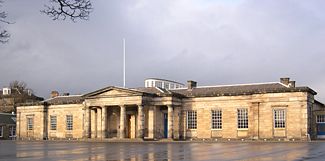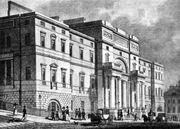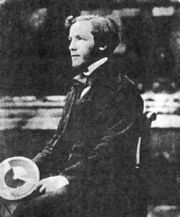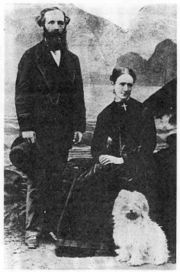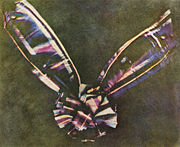James Clerk Maxwell
2008/9 Schools Wikipedia Selection. Related subjects: Astronomers and physicists
| James Clerk Maxwell | |
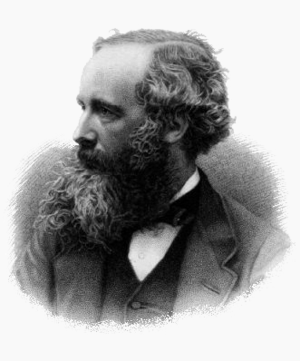 James Clerk Maxwell (1831-1879)
|
|
| Born | June 13, 1831 Edinburgh, Scotland, United Kingdom |
|---|---|
| Died | November 5, 1879 (aged 48) Cambridge, England, United Kingdom |
| Nationality | British |
| Ethnicity | Scottish |
| Fields | Physics and mathematics |
| Institutions | Marischal College, Aberdeen King's College London University of Cambridge |
| Alma mater | University of Edinburgh University of Cambridge |
| Academic advisors | William Hopkins |
| Notable students | George Chrystal |
| Known for | Maxwell's equations Maxwell distribution Maxwell's demon Maxwell's discs Maxwell speed distribution Maxwell's theorem Maxwell material Generalized Maxwell Model Displacement current |
| Notable awards | Smith's Prize Rumford Medal Adams Prize |
| Religious stance | Evangelical anti- positivist |
| Signature |
|
James Clerk Maxwell ( 13 June 1831 – 5 November 1879) was a Scottish mathematician and theoretical physicist. His most significant achievement was the development of the classical electromagnetic theory, synthesizing all previous unrelated observations, experiments and equations of electricity, magnetism and even optics into a consistent theory. His set of equations—Maxwell's equations—demonstrated that electricity, magnetism and even light are all manifestations of the same phenomenon: the electromagnetic field. From that moment on, all other classical laws or equations of these disciplines became simplified cases of Maxwell's equations. Maxwell's work in electromagnetism has been called the "second great unification in physics", after the first one carried out by Newton.
Maxwell demonstrated that electric and magnetic fields travel through space in the form of waves, and at the constant speed of light. Finally, in 1864 Maxwell wrote A Dynamical Theory of the Electromagnetic Field where he first proposed that light was in fact undulations in the same medium that is the cause of electric and magnetic phenomena. His work in producing a unified model of electromagnetism is considered to be one of the greatest advances in physics.
Maxwell also developed the Maxwell distribution, a statistical means to describe aspects of the kinetic theory of gases. These two discoveries helped usher in the era of modern physics, laying the foundation for future work in such fields as special relativity and quantum mechanics. He is also known for creating the first true colour photograph in 1861.
Maxwell is considered by many physicists to be the most influential nineteenth century scientist on twentieth century physics. His contributions to the science are considered by many to be of the same magnitude as those of Isaac Newton and Albert Einstein. In 1931, on the centennial of Maxwell's birthday, Einstein himself described Maxwell's work as the "most profound and the most fruitful that physics has experienced since the time of Newton." Einstein kept a photograph of Maxwell on his study wall, alongside pictures of Michael Faraday and Isaac Newton.
Biography
Early life, 1831–1839
James Clerk Maxwell was born on 13 June 1831 at 14 India Street, Edinburgh, to John Clerk Maxwell, an advocate, and Frances Maxwell (née Cay). Maxwell's father was a man of comfortable means, related to the Clerk family of Penicuik, Midlothian, holders of the baronetcy of Clerk of Penicuik; his brother being the 6th Baronet. He had been born John Clerk, adding the surname Maxwell to his own after he inherited a country estate in Middlebie, Kirkcudbrightshire from connections to the Maxwell family, themselves members of the peerage. Maxwell's parents did not meet and marry until they were well into their thirties, unusual for the times, and Frances Maxwell was nearly 40 when James was born. They had had one earlier child, a daughter, Elizabeth, who had died in infancy. They named their only surviving child James, a name that had sufficed not only for his grandfather, but by many of his ancestors.
The family moved when Maxwell was young to " Glenlair", a house his parents had built on the 1500 acre (6.1 km2) Middlebie estate. All indications suggest that Maxwell had maintained an unquenchable curiosity from an early age. By the age of three, everything that moved, shone, or made a noise drew the question: "what's the go o' that?". In a letter to his sister-in-law Jane Cay in 1834, his father described this innate sense of inquisitiveness:
He is a very happy man, and has improved much since the weather got moderate; he has great work with doors, locks, keys, etc., and "show me how it doos" is never out of his mouth. He also investigates the hidden course of streams and bell-wires, the way the water gets from the pond through the wall ...
Education, 1839–1847
Recognizing the potential of the young boy, his mother Frances took responsibility for James' early education, which in Victorian era was largely the job of the woman of the house. She was however taken ill with abdominal cancer, and after an unsuccessful operation, died in December 1839 when Maxwell was only eight. James' education was then overseen by John Maxwell and his sister-in-law Jane, both of whom played pivotal roles in the life of Maxwell. His formal schooling began unsuccessfully under the guidance of a sixteen-year old hired tutor. Little is known about the young man John Maxwell hired to instruct his son, except that he treated the younger boy harshly, chiding him for being slow and wayward. John Maxwell dismissed the tutor in November 1841, and after considerable thought, sent James to the prestigious Edinburgh Academy. He lodged during term times at the house of his aunt Isabella; while there his passion for drawing was encouraged by his older cousin Jemima, herself a talented artist.
The ten-year old Maxwell, raised in isolation on his father's countryside estate, did not fit in well at school. The first year had been full, obliging him to join the second year with classmates a year his senior. His mannerisms and Galloway accent struck the other boys as rustic, and arriving on his first day at school wearing home-made shoes and tunic earned him the unkind nickname of " Daftie". Maxwell, however, never seemed to have resented the epithet, bearing it without complaint for many years. Any social isolation at the Academy however ended when he met Lewis Campbell and Peter Guthrie Tait, two boys of a similar age, and themselves to become notable scholars. They would remain lifetime friends.
Maxwell was fascinated by geometry at an early age, rediscovering the regular polyhedra before any formal instruction. Much of his talent went unnoticed however, and, despite winning the school's scripture biography prize in his second year, his academic work remained unremarkable, until, at the age of 13, he won the school's mathematical medal, and first prizes for English and poetry.
For his first scientific work, at the age of only 14, Maxwell wrote a paper describing a mechanical means of drawing mathematical curves with a piece of twine, and the properties of ellipses and curves with more than two foci. His work, Oval Curves, was presented to the Royal Society of Edinburgh by James Forbes, professor of natural philosophy at Edinburgh University, Maxwell deemed too young for the task. The work was not entirely original, Descartes having examined the properties of such multifocal curves in the seventeenth century, though Maxwell had simplified their construction.
Edinburgh University, 1847–1850
Maxwell left the Academy in 1847 at the age of 16 and began attending classes at the University of Edinburgh. Having the opportunity to attend Cambridge after his first term, Maxwell decided instead to complete the full course of his undergraduate studies at Edinburgh. The academic staff of Edinburgh University included some highly regarded names, and Maxwell's first year tutors included Sir William Hamilton, who lectured him on logic and metaphysics, Philip Kelland on mathematics, and James Forbes on natural philosophy. Maxwell did not however find his classes at Edinburgh very demanding, and was able to immerse himself in private study during free time at the university, and particularly when back home at Glenlair. There he would experiment with improvised chemical and electromagnetic apparatus, but his chief preoccupation was the properties of polarised light. He constructed shaped blocks of gelatine, subjecting them to various stresses, and with a pair of polarising prisms gifted him by the famous scientist William Nichol, would view the coloured fringes developed within the jelly. Maxwell had discovered photoelasticity, a means of determining the stress distribution within physical structures.
In his eighteenth year, Maxwell contributed two papers for the Transactions of the Royal Society of Edinburgh—one of which, On the Equilibrium of Elastic Solids, laid the foundation for an important discovery of his later life: the temporary double refraction produced in viscous liquids by shear stress. The other was titled Rolling Curves. As with his schoolboy paper Oval Curves, Maxwell was considered too young to stand at the rostrum and present it himself, and it was delivered to the Royal Society by his tutor Kelland.
Cambridge University, 1850–1856
In October 1850, already an accomplished mathematician, Maxwell left Scotland for Cambridge University. He initially attended Peterhouse, but before the end of his first term transferred to Trinity College, where he believed it would be easier to obtain a fellowship. At Trinity, he was elected to the elite secret society known as the Cambridge Apostles. In November 1851, Maxwell studied under William Hopkins, whose success in nurturing mathematical genius had earned him the nickname of "senior wrangler-maker". A considerable part of Maxwell's translation of his electromagnetism equations was accomplished during his time in Trinity.
In 1854, Maxwell graduated from Trinity with a degree in mathematics. He scored second highest in the final examination, coming behind Edward Routh, and thereby earning himself the title of Second Wrangler, but was declared equal with Routh in the more exacting ordeal of the Smith's Prize examination. Immediately after taking his degree, Maxwell read to the Cambridge Philosophical Society a novel memoir, On the Transformation of Surfaces by Bending. This is one of the few purely mathematical papers he published, and it demonstrated Maxwell's growing stature as a mathematician. Maxwell decided to remain at Trinity after graduating and applied for a fellowship, a process that he could expect to take a couple of years. Buoyed by his success as a research student, he would be free, aside from some tutoring and examining duties, to pursue scientific interests at his own leisure.
The nature and perception of colour was a particular interest, and had begun at Edinburgh University while he was a student of Forbes. Maxwell took the coloured spinning tops invented by Forbes, and was able to demonstrate that white light would result from a mixture of red, green and blue light. His paper, Experiments on Colour, laid out the principles of colour combination, and was presented to the Royal Society of Edinburgh in March 1855. This time, it would be Maxwell himself who delivered his lecture.
Maxwell was made a fellow of Trinity on 10 October 1855, sooner than was the norm, and was asked to prepare lectures on hydrostatics and optics, and to set examination papers. However, the following February he was informed by Forbes that the Chair of Natural Philosophy at Marischal College, Aberdeen, had become vacant, and urged to apply. His father assisted him in the task of preparing the necessary references, but died on 2 April at Glenlair before either knew the result of Maxwell's candidacy. Maxwell nevertheless accepted the professorship at Aberdeen, leaving Cambridge in November 1856.
Aberdeen University, 1856–1860
The twenty-five year old Maxwell was a decade and a half younger than any other professor at Marischal, but engaged himself with his new responsibilities as head of department, devising the syllabus and preparing the lectures. He committed himself to lecturing 15 hours a week, including a weekly pro bono lecture to the local working men's college. He lived in Aberdeen during the six months of the academic year, and would spend the summers at Glenlair, which he had inherited from his father.
His mind was focussed on a conundrum which had eluded scientists for two hundred years: the nature of Saturn's rings. It was unknown how they could remain stable without breaking up, drifting away or crashing into Saturn. The problem took on a particular resonance at this time as St John's College, Cambridge had chosen it as the topic for the 1857 Adams Prize. Maxwell devoted two years to studying the problem, proving that a regular solid ring could not be stable, and a fluid ring would be forced by wave action to break up into blobs. Neither met with observations, and Maxwell was able to conclude that the rings must comprise numerous small particles he called "brick-bats", each independently orbiting Saturn. Maxwell was awarded the £130 Adams Prize in 1859 for his essay On the Stability of Saturn's Rings; he was the only entrant to have made enough headway to submit an entry. His work was so detailed and convincing that when George Biddell Airy read it he commented "It is one of the most remarkable applications of mathematics to physics that I have ever seen." It was considered the final word on the issue until it was demonstrated directly by the Voyager flybys of the 1980s.
Maxwell had in 1857 befriended the Principal of Marischal, the Reverend Daniel Dewar, and through him he was to meet Dewar's daughter, Katherine Mary Dewar. They were engaged in February 1858, marrying in Aberdeen on 2 June that year. Comparatively little is known of Katherine, seven years Maxwell's senior: Maxwell's biographer and friend Campbell adopted an uncharacteristic reticence on the subject, though describing their married life as "one of unexampled devotion".
In 1860, Marischal College merged with the neighbouring King's College to form the University of Aberdeen. There was no room for two professors of Natural Philosophy, and Maxwell found himself in the extraordinary position for someone of his scientific stature of being laid off. He was unsuccessful applying for Forbes' recently vacated chair at Edinburgh, the post going to Tait, but was granted instead the Chair of Natural Philosophy at King's College London. After recovering from a near-fatal bout of smallpox in the summer of 1860, Maxwell headed south to London with his wife Katherine.
King's College London, 1860–1865
Maxwell's time at King's was probably the most productive of his career. He was awarded the Royal Society's Rumford Medal in 1860 for his work on colour, and elected to the Society itself in 1861. This period of his life would see him display the world's first colour photograph, develop further his ideas on the viscosity of gases, and proposed a system of defining physical quantities, now known as dimensional analysis. Maxwell would often attend lectures at the Royal Institution, where he came into regular contact with Michael Faraday. The relationship between the two men could not be described as close—Faraday was 40 years Maxwell's senior and showing signs of senility—but they maintained a strong respect for each other's talents.
The time is especially known for the advances Maxwell made in electromagnetism. He had examined the nature of electromagnetic fields in his two-part 1861 paper On Physical Lines of Force, in which he had provided a conceptual model for electromagnetic induction, consisting of tiny spinning cells of magnetic flux. A further two parts to the paper were published early in 1862, in the first of which he discussed the nature of electrostatics and displacement current. The final part dealt with the rotation of the plane of polarisation of light in a magnetic field, a phenomenon discovered by Faraday and now known as the Faraday effect.
Later years
In 1865, Maxwell resigned the chair at King's College London and returned to Glenlair with Katherine.
He wrote a textbook of the Theory of Heat (1871), and an elementary treatise on Matter and Motion (1876). Maxwell was also the first to make explicit use of dimensional analysis, also in 1871.
In 1871, he became the first Cavendish Professor of Physics at Cambridge. Maxwell was put in charge of the development of the Cavendish Laboratory. He supervised every step of the progress of the building and of the purchase of the very valuable collection of apparatus paid for by its generous founder, the 7th Duke of Devonshire (chancellor of the university, and one of its most distinguished alumni). One of Maxwell's last great contributions to science was the editing (with copious original notes) of the electrical researches of Henry Cavendish, from which it appeared that Cavendish researched such questions as the mean density of the earth and the composition of water, among other things.
He died in Cambridge of abdominal cancer on 5 November 1879 at the age of 48. Maxwell is buried at Parton Kirk, near Castle Douglas in Galloway, Scotland. The extended biography The Life of James Clerk Maxwell, by his former schoolfellow and lifelong friend Professor Lewis Campbell, was published in 1882 and his collected works, including the series of articles on the properties of matter, such as Atom, Attraction, Capillary Action, Diffusion, Ether, etc., were issued in two volumes by the Cambridge University Press in 1890.
Christianity
All information available suggests that neither in his adolescence, nor in his later years, did Maxwell reject the fundamental principles of his Christian faith. Ivan Tolstoy, author of one of Maxwell's biographies, remarked at the frequency with which scientists writing short biographies on Maxwell often omit the subject of his religion. Maxwell's spiritual beliefs and related activities have been the focus of several peer-reviewed and well-referenced papers. Attending both Presbyterian and Episcopalian services as a child, Maxwell later underwent an Evangelical conversion (April 1853). This committed him to an anti- positivist position.
Personality
As a great lover of British poetry, Maxwell memorized poems and wrote his own. The best known is Rigid Body Sings closely based on Comin' Through the Rye by Robert Burns, which he apparently used to sing while accompanying himself on a guitar. It has the immortal opening lines
- Gin a body meet a body
- Flyin' through the air.
- Gin a body hit a body,
- Will it fly? And where?
- Flyin' through the air.
A collection of his poems was published by his friend Lewis Campbell in 1882.
Contributions
Electromagnetism
Maxwell had studied and commented on the field of electricity and magnetism as early as 1855/6 when On Faraday's lines of force was read to the Cambridge Philosophical Society. The paper presented a simplified model of Faraday's work, and how the two phenomena were related. He reduced all of the current knowledge into a linked set of differential equations with 20 equations in 20 variables. This work was later published as On Physical Lines of Force in March 1861.
Around 1862, while lecturing at King's College, Maxwell calculated that the speed of propagation of an electromagnetic field is approximately that of the speed of light. He considered this to be more than just a coincidence, and commented "We can scarcely avoid the conclusion that light consists in the transverse undulations of the same medium which is the cause of electric and magnetic phenomena."
Working on the problem further, Maxwell showed that the equations predict the existence of waves of oscillating electric and magnetic fields that travel through empty space at a speed that could be predicted from simple electrical experiments; using the data available at the time, Maxwell obtained a velocity of 310,740,000 m/s. In his 1864 paper A Dynamical Theory of the Electromagnetic Field, Maxwell wrote, The agreement of the results seems to show that light and magnetism are affections of the same substance, and that light is an electromagnetic disturbance propagated through the field according to electromagnetic laws.
His famous equations, in their modern form of four partial differential equations, first appeared in fully developed form in his textbook A Treatise on Electricity and Magnetism in 1873. Most of this work was done by Maxwell at Glenlair during the period between holding his London post and his taking up the Cavendish chair. Maxwell was proven correct, and his quantitative connection between light and electromagnetism is considered one of the great triumphs of 19th century physics.
At that time, Maxwell believed that the propagation of light required a medium for the waves, dubbed the luminiferous aether. Over time, the existence of such a medium, permeating all space and yet apparently undetectable by mechanical means, proved more and more difficult to reconcile with experiments such as the Michelson-Morley experiment. Moreover, it seemed to require an absolute frame of reference in which the equations were valid, with the distasteful result that the equations changed form for a moving observer. These difficulties inspired Albert Einstein to formulate the theory of special relativity, and in the process Einstein dispensed with the requirement of a luminiferous aether.
Colour analysis
Maxwell contributed to the area of optics and colour vision, and is credited with the discovery that colour photographs could be formed using red, green, and blue filters. In 1861 he presented the world's first colour photograph during a Royal Institution lecture. He had Thomas Sutton, inventor of the single-lens reflex camera, photograph a tartan ribbon three times, each time with a different colour filter over the lens. The three images were developed and then projected onto a screen with three different projectors, each equipped with the same colour filter used to take its image. When brought into focus, the three images formed a full colour image. The three photographic plates now reside in a small museum at 14 India Street, Edinburgh, the house where Maxwell was born.
From 1855 to 1872, he published at intervals a series of valuable investigations connected with the Perception of Colour and Colour-Blindness, for the earlier of which the Royal Society awarded him the Rumford Medal. The instruments which he devised for these investigations were simple and convenient in use. For example, Maxwell's discs were used to compare a variable mixture of three primary colours with a sample colour by observing the spinning "colour top."
Kinetic theory and thermodynamics
One of Maxwell's major investigations was on the kinetic theory of gases. Originating with Daniel Bernoulli, this theory was advanced by the successive labours of John Herapath, John James Waterston, James Joule, and particularly Rudolf Clausius, to such an extent as to put its general accuracy beyond a doubt; but it received enormous development from Maxwell, who in this field appeared as an experimenter (on the laws of gaseous friction) as well as a mathematician.
In 1866, he formulated statistically, independently of Ludwig Boltzmann, the Maxwell-Boltzmann kinetic theory of gases. His formula, called the Maxwell distribution, gives the fraction of gas molecules moving at a specified velocity at any given temperature. In the kinetic theory, temperatures and heat involve only molecular movement. This approach generalized the previously established laws of thermodynamics and explained existing observations and experiments in a better way than had been achieved previously. Maxwell's work on thermodynamics led him to devise the thought experiment (Gedanken) that came to be known as Maxwell's demon.
In 1871, he established Maxwell's thermodynamic relations, which are statements of equality among the second derivatives of the thermodynamic potentials with respect to different thermodynamic variables.
Control theory
Maxwell published a famous paper On governors in the Proceedings of Royal Society, vol. 16 (1867-1868). This paper is quite frequently considered a classical paper of the early days of control theory. Here governors refer to the governor (device) or the centrifugal governor used in steam engines.
Legacy
Maxwell was ranked 24th on Michael H. Hart's list of the most influential figures in history and 91st on the BBC poll of the 100 Greatest Britons. His name is honoured in a number of ways:
- The maxwell (Mw), a compound derived CGS unit measuring magnetic flux.
- Maxwell Montes, a mountain range on Venus, one of only three features on the planet that are not given female names.
- The Maxwell Gap in the Rings of Saturn.
- The James Clerk Maxwell Telescope, the largest submillimetre-wavelength astronomical telescope in the world, with a diameter of 15 metres.
- The 1977 James Clerk Maxwell Building of the University of Edinburgh, housing the schools of mathematics, physics, computer science and meteorology.
- The James Clerk Maxwell building at the Waterloo campus of King's College London, in commemoration of him being Professor of Natural Philosophy at King's from 1860 to 1865. The university also has a chair in Physics named after him, and a society for undergraduate physicists.
- The £4 million James Clerk Maxwell Centre of the Edinburgh Academy was opened in 2006 to mark his 175th anniversary.
- James Clerk Maxwell Road in Cambridge, which runs beside the Cavendish Laboratory.
- The University of Salford's main building was named after him.
- Maxwell bridge, a bridge circuit involving resistors, a capacitor and an inductor
Publications
- On the Description of Oval Curves, and those having a plurality of Foci. Proceedings of the Royal Society of Edinburgh, Vol. ii. 1846.
- Illustrations of the Dynamical Theory of Gases. 1860.
- On Physical Lines of Force. 1861.
- A Dynamical Theory of the Electromagnetic Field. 1865.
- On Governors. Proceedings of the Royal Society, Vol. 16 (1867-1868) pp. 270–283.
- Theory of Heat. 1871.
- On the Focal Lines of a Refracted Pencil. Proceedings of the London Mathematical Society s1-4(1):337-343, 1871.
- A Treatise on Electricity and Magnetism. Clarendon Press, Oxford. 1873.
- Molecules. Nature, September, 1873.
- On Hamilton's Characteristic Function for a Narrow Beam of Light. Proceedings of the London Mathematical Society s1-6(1):182-190, 1874.
- Matter and Motion, 1876.
- On the Results of Bernoulli's Theory of Gases as Applied to their Internal Friction, their Diffusion, and their Conductivity for Heat.
- " Ether", Encyclopaedia Britannica, Ninth Edition (1875-89).
- An Elementary Treatise on Electricity Clarendon Press, Oxford. 1881, 1888.
